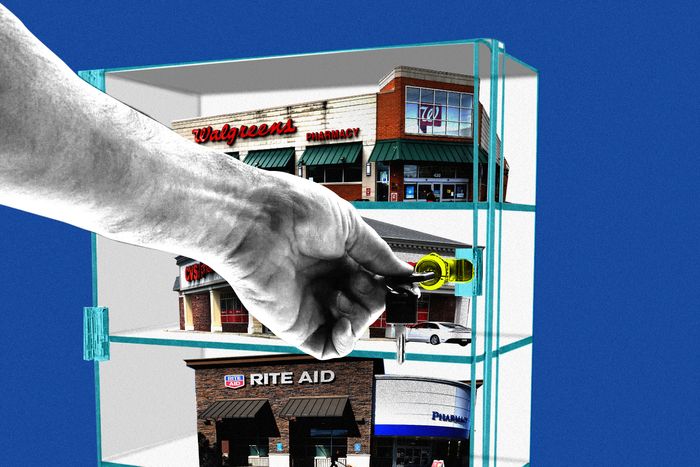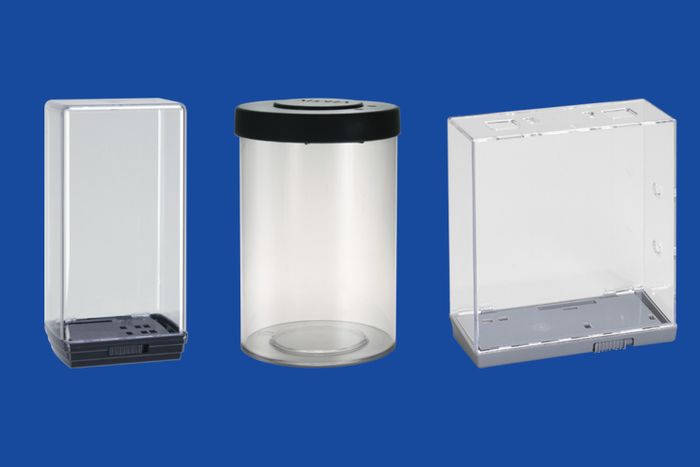
Last summer, a snapshot of a single tin of Spam locked inside its very own clear plastic case went viral. The writer who shared the image on Twitter joked that the Port Authority Duane Reade had “finally created something of beauty, a sort of Jeff Koons homage.” Art or not, the image of the closely guarded product fueled a familiar cycle of outrage. The Post restaged the photograph with a caption about “thieves” who “swarm” stores amid “spiraling crime.” Other outlets, from Fox to CBS and the Daily Mail, also latched on to the image, calling it a symbol of a national crisis.
Even if you’re not particularly prone to hand-wringing about crime, it’s impossible to ignore the fact that nowadays, the aisles of a chain store like Walgreens or Target feel more like the halls of a natural-history museum, where precious specimens (in this case, toothpaste or shampoo) are entombed in glass vitrines. It’s hard to prove exactly how bad shoplifting has gotten, but retailers have aggressively overhauled their stores with locks and clear acrylic to the extent where shoppers have been turned off by the hassle, preferring to buy online rather than summon a store employee for some floss. In some neighborhoods, customers feel racially profiled by what has been placed under lock and key. When a Target opened in Flatbush this summer with aisle after aisle of locked shelves, a local organizer told BK Reader that “a lot of people feel like this is treating the community like we’re hoodlums and thieves.”
Retailers say that these loss-prevention measures are needed to make shopping better — a tool to ensure shelves are stocked. But they are also placing themselves in a bind: The more they lock up products, the more they alienate paying customers and the less inventory they sell. Experts estimate that sales of a product drop 70 to 80 percent when it’s locked up since shoppers are too impatient to wait around for a sales associate. In fact, the only group that seems to be coming out on top are the manufacturers of these security devices.
In the repertoire of theft-prevention products, the Koonsian case guarding the Spam has perhaps become the most infamous. But its journey to front-page news has a decades-long lead-up. It starts in New Jersey, at a company called Alpha High-Theft Solutions. Alpha was founded about 50 years ago as a plastics manufacturer that mainly supplied the music industry with 8-track tape cartridges and then, as music media changed, display cases for cassettes and CDs. About 25 years ago, when record stores asked for a product that could secure those items from shoplifters, Alpha invented the Keeper. It’s a simple design: a clear plastic container that can be opened by a magnetic key, with a built-in RFID chip (a radio frequency tracker) that triggers an alarm if someone tries to dash out of a store with it. About 15 years ago, as record shops started to shutter, more of Alpha’s business came from big-box retail, supermarkets, and drugstores. They had noticed the rising theft of household items and asked the company to adapt its Keepers to guard the disappearing products. Retailers liked Keepers because they allowed people to shop how they normally would (they picked the encased product off the shelf and put it in their cart as usual, leaving the work of unlocking them to the cashiers at the register), and no extra staff are needed to unlock display cases. Now, Alpha makes 85 different sizes of Keepers and produces 27,000 per day at its factory in Canton, Ohio. Alpha’s Keepers are “in 95 percent of the top 500 retailers globally,” says Stuart Rosenthal, the vice-president of sales and marketing at Alpha, though he declined to say which stores specifically.
But this doesn’t mean everything goes in a Keeper. Retailers and product manufacturers have requested them specifically for high-theft products: Tide Pods, Olay Regenerist skin care, and Dove body wash, to name a few. Keepers are also popular for teeth-whitening strips, razor blades, and batteries. Alpha also makes a series of “high-end” Keepers with clearer acrylic and a stepped base that looks like a pedestal to hold fragrances, and has designed custom-colored blue cases for Gillette and green ones for the cannabis industry. Seeing Keepers used for food is a “somewhat new phenomenon,” Rosenthal says. The company doesn’t actively promote the use of its products for food because “we don’t want to get involved with FDA regulations,” he explains. But that doesn’t stop staff at a store from placing shelf-stable food, say, tinned meats, into them.
In the years since the Keeper was introduced, a vast industry of retail security products has emerged: devices ranging from help buttons to gated display shelves and even cases equipped with AI sensors that can tell the difference between a regular customer and a shoplifter. (That’s the Freedom Case from Indyme, which lets customers unlock a case with their smartphone.) Retailers are trying to strike a balance between letting paying customers grab the items they want and preventing theft, and manufacturers are eager to introduce new technology that claims to do both. A company called Sennco sells encased shelves that remain unlocked but can be remotely locked if a store associate sees a shoplifting sweep. The brand recently released a display case inspired by a vending machine that requires shoppers to turn a couple of knobs to dispense products, essentially limiting them to a single item at a time. It’s somewhat ironic that vending machines, which were meant to make shopping more convenient, are now installed in stores to make it slightly harder.
Despite the slew of new security products, the Keeper is still around because of how versatile it is. As soon as a store notices that a certain product is disappearing, they’re able to put them in Keepers a lot faster and cheaper than behind locked cases. Each one costs between $4 and $6. Meanwhile, Rosenthal says retailers sell about 40 percent more product that’s kept in a Keeper versus behind a lock and key, and Alpha advertises that they provide “the security of locked cabinets with the benefits of open merchandising.” But, of course, they’re not a theftproof solution. Unlike the locked display shelves that target “organized” theft, individually locked cases are meant for “the 99 percent of customers that may be a potential shoplifter,” Rosenthal says. “Our product protection makes them think twice about taking it.” But do they really? If someone really wanted to steal what’s in a Keeper, they could easily drop it in a bag and walk outside. A Duane Reade clerk even told Fox News they don’t stop anything: “It’s security theater. If you needed it, you would stomp on it.”
After the Spam case went viral, I started paying closer attention to what was locked up in chain stores and how. The Target in Atlantic Terminal had installed clear locked doors that covered all the shelves in its lotion, toothpaste, deodorant, and body-wash aisles. It read like surrender. It wasn’t singling out any particular brands or items for extra security; everything was just behind one big door. The Soho Duane Reade seemed more selective — a spokesperson maintains that what’s stolen most often determines what’s locked away — but sometimes the type of security felt arbitrary: Beef jerky is locked up, but the pistachios (a more expensive item) were behind a lift-up flap. It made sense that brand names like Dove body wash required a store associate with a key, but the generic dupe was behind a slide-to-open display. In the pharmacy, most vitamins required you to press a button for a sales associate, except for vitamin C and Flintstones gummies (probably because they were less targeted by shoplifters). You needed help to buy DayQuil, but not Theraflu. The two or three sales associates I saw on the floor looked frazzled and harried. I can’t imagine how many times a day someone asks them to free a Slim Jim. The store reserved its Keepers for a display of $30 La Roche-Posay face creams, one of the most expensive items in the beauty aisle.
Seeing the French brand (a favorite of celebrities like Sarah Jessica Parker and Kate Moss) in Keepers, I wondered if perhaps its next act will be more about merchandising than security. When Alpha rolled out baby formula–size Keepers in 2011, it found that shoppers preferred the formula that was stored in the Keepers. “We asked customers, ‘Why did you choose this one when the same one next to it isn’t in a box?’ and heard, ‘Well, I felt like this one was more secure,’ meaning not tampered with,” Rosenthal says. “They thought the Keeper was for a product-protection issue instead of a theft issue.” It turns out they can actually make a product seem more desirable.
Depending on the viewer, the Keeper, with its simple design, seems to have become a projection screen for our desires and fears and anxieties: It’s evidence of societal decline, or a reminder of racial profiling, or even a symbol of luxury and care. But perhaps most of all, it’s served as a convenient red herring for retailers who invoked a shoplifting crisis to distract us from a business model that just hasn’t evolved fast enough to meet our moment. In the meantime, as stores continue to shut down, it appears that the Keeper might be poised to outlast the retailers that rely on them.





